Should i install solar systems for heating: a review of
Energy-saving technologies do not stand still - every year more and more offers appear on the market for the sale and installation of one or another economical house heating systems. Perhaps one of the most unusual and attractive offers is helio-heating.
In this article we will look at what this is all about, and also look into the features of this technology. Also touch on some of the nuances of the installation.
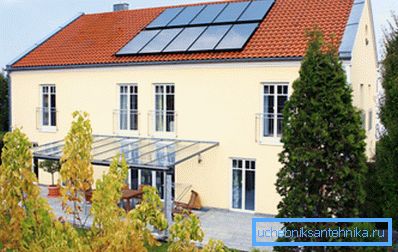
So, let's begin.
What is a heliosystem
In short, the essence of such a system is that it converts solar energy into other types of energy. Heliosystems are currently used to obtain either thermal or electrical power.
The main component here is the solar collector. The main difference between the product and the solar battery is that the latter is a “supplier” of electricity directly. And the collector performs the heating of the coolant.

That is, the device accumulates solar heat, which is transferred by visible portable light and infrared radiation, and then "transfers" all the accumulated heat to the water of the heating system and hot water supply.
This leads to the main application areas of reservoirs:
- Heating and hot water supply in cottages, houses and cottages.
- Heated water in the pools.
- Heating of the heat carrier in systems of water heat-insulated floors.
- Additional heating element in large industrial buildings and administrative institutions.
Now we will begin a more detailed review.
Principle of operation
A standard collector is a square or rectangular panel, under which is located the plate - the "absorber" of heat. Inside the plate, a heat-transfer fluid passes, which, after heating, passes into a special storage tank, where most of the hot water is collected.
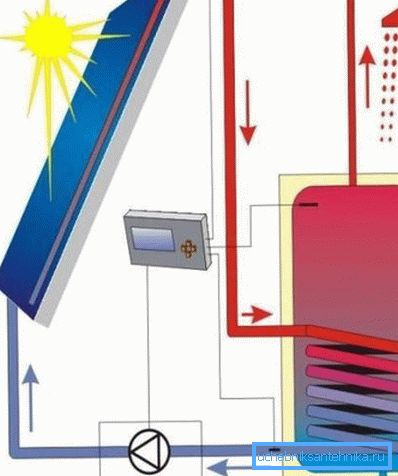
Note! Cumulative capacity should be tried to insulate as efficiently as possible so that the water cooled as slowly as possible. If it is ordinary steel without any insulating layers, the water will cool down literally overnight in the summer and a couple of hours in the winter.
The principle here is quite simple - the larger the surface area of the structure, the more heat the system is capable of creating. In fact, the principle of the greenhouse operates here - the plane heats up and a huge amount of hot air accumulates inside the collector.
At the same time, the design has a very good, well-thought-out thermal insulation, due to which the accumulated heat does not "go" beyond the panel, but is guaranteed to remain inside.
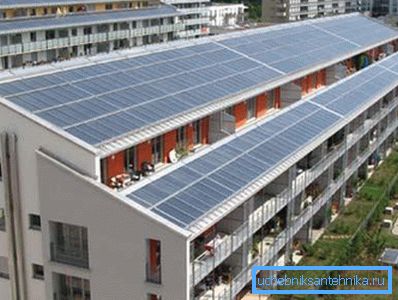
Automatically it turns out that the heliosystem for heating has such an important quality as absolute environmental friendliness. After all, when water is heated, there are no harmful emissions of carbon dioxide and toxic substances.
Designs are of two types:
- Active systems. In them hot water is fed into the tank with the help of special electric pumps.
- Passive. Here the circulation of water occurs in a natural way.
With the basic data finished, now we will get acquainted with features of the system.
Advantages and disadvantages
It is best to make out everything in the comparative table.
| Pluses of solar systems: | Minuses: |
| High level of efficiency - with proper installation and calculation, reducing the cost of heating a house can reach 30-50%. It all depends on how correctly the capacity of the equipment is calculated and how well the house is insulated. As for the hot water supply, then you can reach the bar in 90-95%. | There is a direct dependence on the weather and the power of sunlight. Naturally, in cloudy weather, the solar system will heat the water rather slowly. In addition, there is such a negative factor as seasonal dependence - in most regions during the winter period it’s not very sunny. |
| Long service life, which is usually at least 25 years! | Installation instructions, albeit fairly simple, but on their own this assembly is better not to do. Firstly, if the work is performed not by the sellers, then the warranty period is automatically reduced, and, secondly, a certain experience and knowledge is nevertheless required. |
| During operation, constant monitoring is not required, in fact, you can not check anything for months. | The system can not work effectively everywhere. For example, if your apartment goes to the north or shadow side, then installing a collector is meaningless, because the heating in such a situation will be very weak. |

And, of course, it is impossible not to note the main feature of the collectors - the price of systems of this type is rather high and without a “sight” for many years or for large volumes of hot water - it is impractical to buy them.
That is, if you live in a house for several years, then it will be cheaper to overpay for other energy. But if you make such a purchase for a seaside boarding house, for example, or for a house where you live permanently, then this solution is definitely profitable.
Now it is worth touching on one important point.
Types of solar systems
In the market you can find two models of collectors - flat and vacuum, and this nuance can be a hardship, because the sales consultants are far from always able to explain sensibly and what is the difference. In addition, sometimes the store employees may face the task of declining the buyer in the direction of a single option, which, by the way, is not always optimal.
We will talk about how one heliosystem differs from another in order to make your selection process as easy as possible.
Let's start the review of this moment.
Vacuum collectors
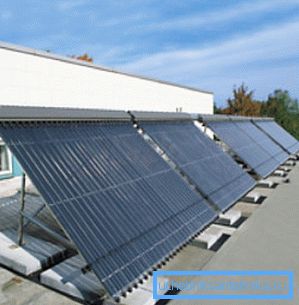
The design of this type is arranged according to the principle of a thermos - tubes with heat carrier are inserted into tubes of a larger diameter and it turns out that a vacuum layer is created between them, which serves as a heat-insulating layer. In principle, it is believed that this layer can save about 95% of the accumulated heat.
Pay attention that the heat carrier in such systems can serve not only water, but also practically any antifreeze. This property allows you to maximize the protection of pipes or radiators from breaking in the winter in the event of an emergency stop of the system.
The product of vacuum type possesses such positive qualities:
- Maintainability. Since the device consists of tubes, then if one of them breaks down, it can easily be replaced with another. In this case, as you understand, the replacement of the tube at a cost is much lower than the replacement of the device entirely.
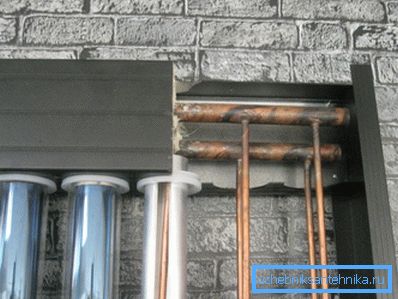
- Ability to heat water to boiling point.
As for the shortcomings, we can distinguish the following features:
- The tubes are rather fragile, so the panel is afraid of mechanical shocks and loads. Even with a small crack on the glass surface - the damaged collector element instantly loses its heat-saving properties.
- It is difficult to care for a vacuum product, as it is quite problematic to clean each tube from snow, dust or dirt. First, the installation site still needs to be reached, and, secondly, if there are many drives, then wipe all the tubes - that is still work.
And consider the second type of heaters.
Flat panels
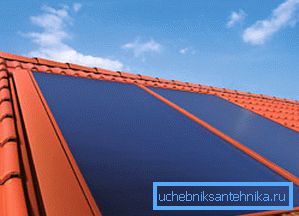
In fact, these products are thin metal boxes, which are closed either with glass or plastic lids. But already inside such a box all the same tubes with a heat carrier are located. Boxes have a fairly good level of thermal insulation and the tubes inside them can be made of frosted or clear glass.
Tip: It is best to use options with frosted glass, in which the level of iron content is not very high. Such solutions are a bit more expensive, but this material transmits solar radiation by almost 100%. That is, heating the coolant will be faster.
Flat products are harder and more expensive to repair with your own hands due to the fact that when the device fails, you will have to replace the entire panel. But on the other hand, due to the presence of a protective cover and a box, the resistance to mechanical damage is rather high here.
Well and leaving - agree, it is much easier to wipe a flat big surface, than the mass of tubules.
In principle, if we talk about which option is better, then there is no universal answer. Need to focus on the budget and features of the task. If a solution is needed in which the temperature of the water needs to be raised only 20-40 degrees higher than the environmental indicators, then a flat collector is optimally suited.
Well, if you need the most hot water and there is no danger of mechanical damage, then it is better to take a vacuum equivalent.
In general, it is worth remembering that the main purpose of heliosystems is teamwork, in combination with another heat generator. That is, the solar system for heating primarily heats the coolant when the power of sunlight allows it, and the gas or electric heating boiler, if necessary, bring the liquid to a higher temperature.

Only in such a “bundle” this technology will be profitable and effective. Of course, you can try to make an absolutely autonomous solar heating and hot water supply - and this is real, only costs will be very high.
Indeed, in our country, changeable weather conditions, which means that we will have to install a large number of panels, while in regions with a very harsh climate, we still have to use additional boilers for safety purposes.
Now let's touch on another point.
Installation Recommendations
In this list we will list those moments to which installers must approach with all responsibility.
So, such nuances are important:
- Heliopolis area. That is, take care to check whether you have purchased enough panels. It is also often the case that a store in the pursuit of profit sells too many items.
- Tilt angle of collectors.

- The volume of the storage tank.
In all cases, the best solution would be to consult an independent specialist and go to the store with these calculations.
This concludes our review, and you can go to the results.
Conclusion
We have considered what a heliosystem is for heating, figured out what they are, and also briefly touched upon those important points that need to be taken into account during installation.
We hope that the information will be useful to you in business, and you will be able to purchase a truly suitable system and make sure that it is installed correctly. If the information did not seem to be enough, then turn your attention to the additional video at the end of this article.